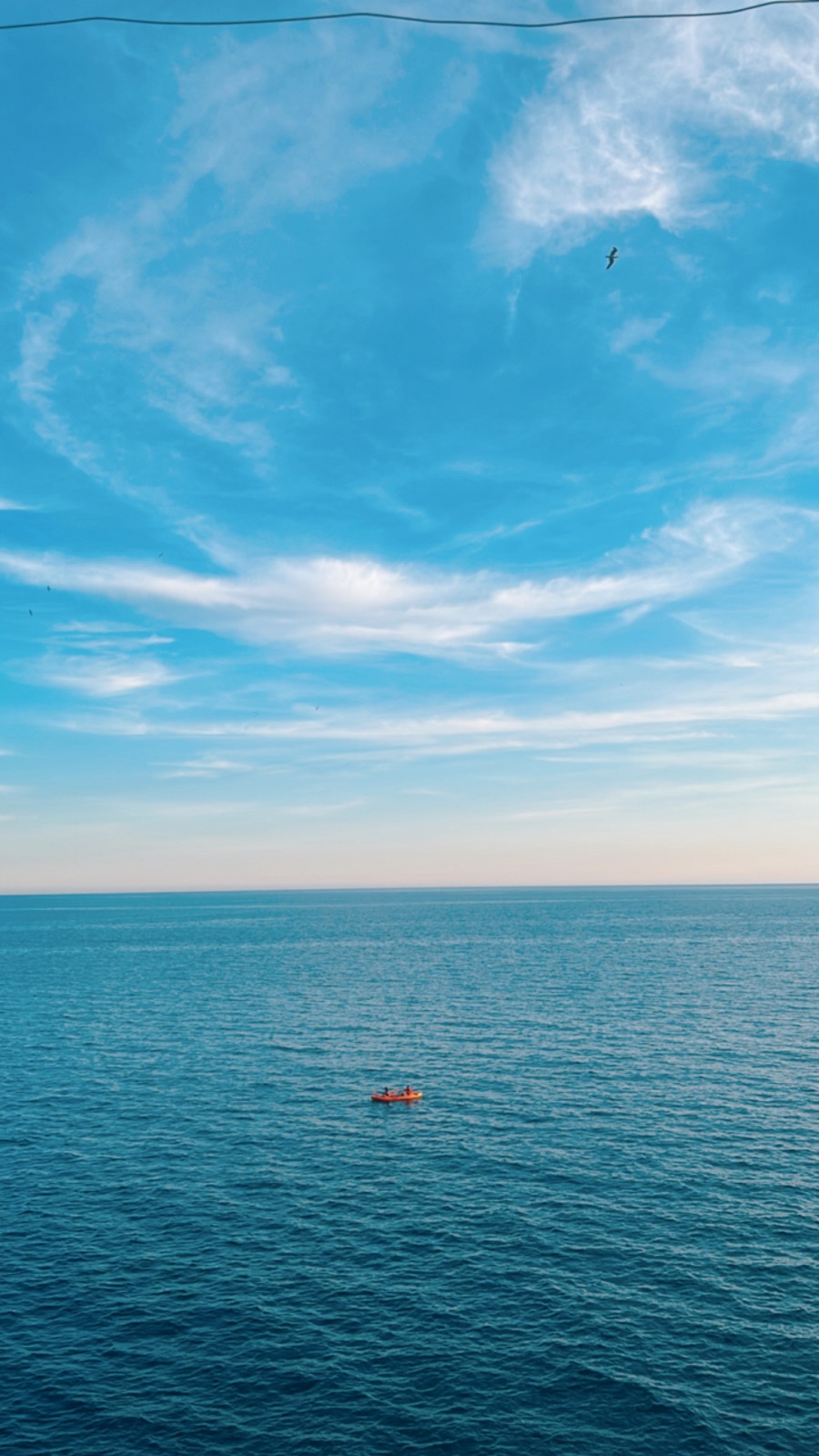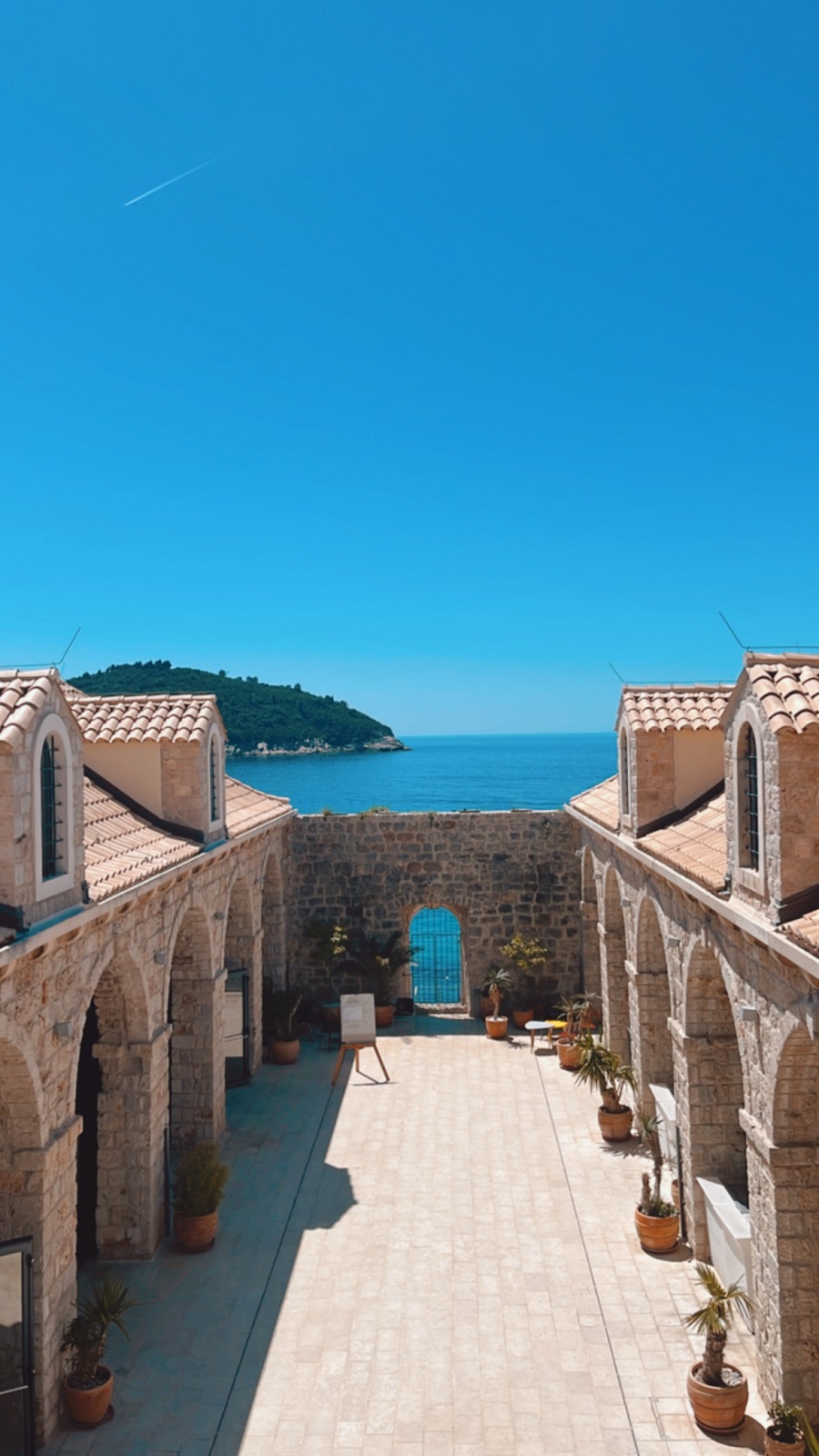Catering to Digital Nomads: Official Dubrovnik Long Stay Website Launched
May 28, 2022 - A destination long associated with short visits continues its journey of diversification aimed at the digital market and longer-stay tourist. Meet Dubrovnik Long Stay, a new official website.
It has been a really interesting two years working with the City of Dubrovnik and tourist board since my first meeting with Dubrovnik Mayor, Mato Frankovic back in July 2020. His receptiveness to explore new tourism avenues was very refreshing, and we started working on some new digital nomad initiatives with Saltwater Nomads. With many destinations simply waiting for the pandemic to pass, Croatia (with its new digital nomad permit) and Dubrovnik were busy and prominent. Saltwater Nomads delivered the first-ever digital nomad conference in Croatia, Dubrovnik for Digital Nomads, which was followed by the award-winning Dubrovnik Digital Nomads-in-Residence programme (DNIR) in April 2021, and recent Work. Place. Culture. conference which took place earlier this month.
The DNIR project was particularly illuminating, and it was a pleasure to watch the city, tourist board, community and resident nomads co-creating a strategy for the city to become more attractive to remote workers in the future. One of the many recommendations from the resident nomads was that Dubrovnik was perceived as a 2-day destination, whereas many nomads on social media were looking to try a Croatian destination for 30 days or so. If there was no information or marketing about longer-term stays, then there was little chance that nomads would be heading in that direction. A suggestion to create a website called Dubrovnik Long Stay could promote a different image of the city, catering to the needs of those who were more interested in spending a longer period, perhaps with working remotely built into the plan.
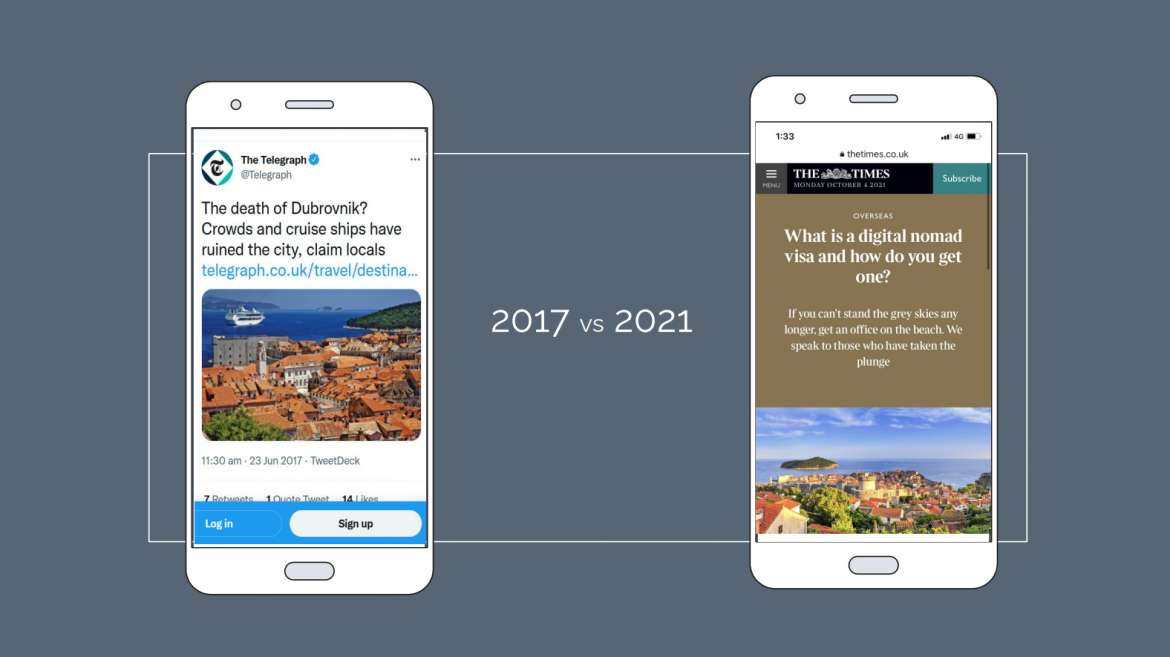
One thing that has really impressed me with the cooperation with Dubrovnik has been how willing both the city and tourist board have been not only to implement recommendations, but to go even further. Making lasting change takes more than a couple of conferences and strategy exercises if the recommendations are not followed up. Changing the perception of a destination takes time, but there are already some encouraging results, as the two British newspaper headlines - one from 2017 and one from 2021 - show.
Dubrovnik has responded well to the challenge, and the city has some pretty cool features for nomads. In addition to adding co-working (and soon co-living) spaces, the tourist board has reached out to local businesses to see who would like to support the digital nomad community in the form of discounts and special offers. There has been a great response, and the Dubrovnik Digital Nomad Card will soon be available. The tourist board has also established a digital nomad concierge service point at its main Pile Gate office, where digital nomads can register and receive a DN information pack.
Nothing spreads faster than the spoken word or a hearty recommendation, and the latest collaboration between the City of Dubrovnik, Dubrovnik Tourist Board and Saltwater Nomads has been the Dubrovnik Digital Nomad Ambassador program. Mandy Fransz (one of the top 10 LinkedIn voices on remote work), and Yvette Pelgrom, have done an excellent job and are now continuing their ambassadorship on Korcula. So what did they make of Dubrovnik as a nomad destination? Read more in The Ultimate Guide for Digital Nomads in Dubrovnik.
The latest addition to Dubrovnik's impressive digital nomad offer went live this week - the latest implemented recommendation from DNIR - the Dubrovnik Long Stay website - check it out here.
Lots of practical information for longer-term renters, including accommodation options and co-working spaces, as well as the latest news and events. More details on the DN card will appear once it is launched, and if you are considering coming down to the southern coast of Croatia for an extended stay, a website to bookmark for sure.
To learn more about Dubrovnik, check out the TC Dubrovnik in a Page guide.
For more news and features about digital nomads in Croatia, follow the dedicated TCN section.
2022 Revised Budget Adopted
ZAGREB, 27 May 2022 - The parliament on Friday passed by a majority vote a revised budget for 2022, whereby the expenditure side will increase by HRK 10.9 billion to HRK 184.7 billion and the revenues will go up by 6.6 billion to HRK 171 billion.
As a result, this year's budget deficit will widen from the initial projections of 2.6% of the GDP to the deficit-to-GDP ratio of 2.8%.
Most of the rejigged budget outlays refer to the health system, in the amount of HRK 4 billion, of which the largest share will be used to cover hospitals' and pharmacies' debt to suppliers.
The opposition MPs who voted against the budget revision criticized the proposal as bad.
In mid-may, the Fiscal Policy Commission said that it believed that the proposed 2022 budget revision was appropriate to the current circumstances however, this independent body underscores that it is necessary for Croatia to absorb more EU funds to fund investments and schemes to boost productivity and implement cost-cutting reforms.
In a press release released on 17 May, the commission underscored the need to implement reforms to limit expenditure for healthcare, pensions, and unemployment benefits.
Also today, the parliament passed a law on the registry of persons with disabilities.
The legislation on investment stimulation was today endorsed, providing for some additional benefits for users of state subsidies for investments in the event when their projects are affected by extraordinary circumstances caused by the COVID-19 pandemic.
(€1 = HRK 7.529160)
For more, check out our politics section.
Plenković: Gov't Will Do Its Best to Protect Indicted Air Force Pilots
ZAGREB, 27 May 2022 - Croatian Prime Minister Andrej Plenković said on Friday that government officials had met with Croatian Air Force pilots who had taken part in the 1995 Operation Storm, stressing that all available mechanisms would be used to protect them from an indictment from Serbia.
"We discussed the latest developments following media reports that indictments are being prepared in Serbia, at the request of their prosecutor, against four pilots, Air Force commanders at the time of the military and police operation Storm," Plenković said at the start of a government session.
He said that they still did not have any concrete documents or requests for legal assistance but that they would do everything to protect the pilots.
"As before, the government will use all the available mechanisms to protect the Croatian pilots and the dignity of the Homeland War, thus sending a clear message about the fundamental values on which free Croatia is founded," said Plenković.
He said that during the Homeland War no orders had been issued, especially not in the Air Force, that would in any way be directed against civilian targets, repeating that the Homeland War, notably its operations Storm and Flash, had been part of efforts to liberate, protect and reintegrate Croatian territory.
Plenković repeated that with the indictment Serbia "is making a step backward in reconciliation", stressing that he had conveyed his dissatisfaction with the indictment to Serbian President Aleksandar Vučić at a meeting in Davos.
The Serbian war crimes prosecutor has issued an indictment charging four Croatian officers with having ordered, on 7 and 8 August 1995, a missile attack on a refugee convoy, but the prosecutor's office has said that the indictment is not final and that the proceedings currently underway are not public.
According to unofficial reports, the indictment refers to Croatian Air Force pilots Vladimir Mikac, Zdenko Radulj, Željko Jelenić, and Danijel Borović.
For more, check out our politics section.
Fan Safety in Croatia: HNS, MUP, Hajduk, and Dinamo Reach Three Conclusions
May 27, 2022 - Fan safety in Croatia was discussed at the Croatian Football Federation between HNS, MUP, Hajduk, and Dinamo.
A meeting of Croatian Football Federation representatives was held today on the Croatian Football Federation premises, led by President Marijan Kustić, Police Directorates headed by Chief of Police Nikola Milin, and GNK Dinamo and HNK Hajduk, led by Presidents Vlatka Peras and Lukša Jakobušić. The meeting was held on the topic of security and the organization of football matches, reports HNS.
In a constructive atmosphere and after exchanging views, the following conclusions were reached:
1. All stakeholders in football matches are invited to comply with safety regulations at sports competitions.
2. An agreement will be concluded between the Ministry of the Interior and the Croatian Football Federation on implementing measures at high-risk matches and matches where a larger number of visiting fans is expected. In doing so, existing good practices from domestic and international matches will be taken into account. The agreement will be drawn up until the beginning of the new competition year, i.e., the Super Cup match.
3. Fan clubs will be invited to get involved in drafting the said agreement by giving their suggestions and pointing out the problems identified.
It was also agreed that representatives of the Federation, clubs, and the police would constantly communicate regarding the preparation and conduct of football competitions.
"I must emphasize that the term 'freedom to the fans' does not refer to those fans who in any way cause riots, who in any way participate in dishonorable acts and there are institutions for that. This refers to those unjustly detained and I hope that will be determined in the end. We are a fan club, not only do we have an obligation, but we stand firmly behind them. That is why we responded to this meeting," said Hajduk president Lukša Jakobušić after the meeting with HNS, Dinamo, and police representatives.
For more, make sure to check out our dedicated sports section.
Croatia Logs 325 COVID-19 Cases, No Related Deaths
ZAGREB, 27 May 2022 - In the past 24 hours, 325 coronavirus cases were registered in Croatia, the national COVID-19 crisis management team said on Friday, noting that there were no new deaths.
There are 2,659 active cases, including 229 hospitalized patients, four of whom are on ventilators.
To date, Croatia has registered 1,135,874 coronavirus cases and the death toll is 15,978.
For all you need to know about coronavirus specific to Croatia, make sure to bookmark our dedicated section and select your preferred language if it isn't English.
Five Croatian Diplomats in Russia Declared Personae Non Gratae
ZAGREB, 27 May 2022 - Moscow has declared five employees of Croatia's embassy in Russia personae non-gratae, the Russian Ministry of Foreign Affairs reported on Friday as carried by the TASS news agency.
"In response to hostile steps taken earlier by Zagreb to reduce the size of Russia's diplomatic mission, (Croatian ambassador) Tomislav Car received a note which declares five employees of the Croatian Embassy in Moscow personae non-gratae," Russia's Ministry of Foreign Affairs has reported.
It notes that a "strong protest was expressed to Croatia's ambassador because of unfounded attempts by Croatian authorities to blame Russia for war crimes in Ukraine and provide military assistance to the neo-Nazi regime in Kyiv."
On 11 April Croatia announced that it had expelled 18 Russian diplomats and six administrative staff serving in Zagreb.
A day later the Russian Federation slammed the expulsion of the diplomats and sent a strong protest to Croatia's authorities and threatened to reciprocate.
For more, check out our politics section.
Croatia and Saudi Arabia Friendly Scheduled Ahead of 2022 World Cup
May 27, 2022 - Croatia and Saudi Arabia will play a friendly match on November 16 in Riyadh ahead of the 2022 World Cup in Qatar.
The Croatia national football team will play a friendly match against Saudi Arabia in Riyadh on November 16, 2022, reports HNS.
This will be the last test for Croatia before the 2022 World Cup in Qatar. Saudi Arabia is the 49th national team in the world based on the FIFA rankings, and will also play at the World Cup, in Group C with Argentina, Mexico, and Poland.
"We are pleased about this agreement with Saudi Arabia, which will be a good last test for the Vatreni before the World Cup. Thus, we fulfilled the wish of the coach and our staff to play a match near Qatar for acclimatization. From the organizational point of view, HNS will, as always, provide maximum support to the national team before and during the World Cup, which the 2018 World Cup finalists deserve. I believe that with the quality and togetherness, which the Croatia national team certainly has, we will once again have reason to rejoice with the Vatreni," said the President of the Croatian Football Federation, Marijan Kustić.
"Given the unusually short preparations for the World Cup, we wanted to be in the Middle East from the first day of the gathering to acclimatize as soon as possible to the conditions that await us in Qatar and therefore see this meeting in Riyadh as an ideal stop for the final test before the World Cup. Saudi Arabia is a regular participant in the World Cup, one of the best teams in Asia, and we will be tested against a non-European team, which we rarely play against, and which will certainly be motivated against the World Cup finalists," said Croatia coach Zlatko Dalić.
"We are thrilled that we will play the last preparatory match before the World Cup against the current World Cup finalists. We want to get the most out of this game in technical and tactical terms. It will be a big test for our players before the first game at the World Cup in Qatar," said the coach of Saudi Arabia, Herve Renard.
The national team will gather on November 14, and after the match against Saudi Arabia on November 18, they will stay at their camp in Doha.
As a reminder, Croatia will open the World Cup in Qatar on November 23 at 11 am at the Al Bayt Stadium against Morocco. The second match will be played on November 27 at 5 pm at the Khalifa International Stadium against Canada. The third is on December 1 at 4 pm at Ahmad Bin Ali Stadium against Belgium.
For more, make sure to check out our dedicated sports section.
Top 10 Historic Sites to Visit Along the Croatian Adriatic Coast
May 27, 2022 - While Croatia is the country to find paradise with its beaches, islands, activities, and parties, there are plenty of historic sites on the Croatian Adriatic coast that should be on your travel itinerary.
From Istria to Dubrovnik, the Croatian Adriatic coast has witnessed throughout history the presence of various civilizations and cultures that found it the ideal land with resources to settle. If you believe that Croatia is an earthly paradise, then surely you would have coincided with the Illyrians, the Greeks, the Celts, the Romans, and the Byzantines, who left evidence of their passage along the coast.
Whether you are coming by plane, bus, or in your own car or camper, it is always a good idea to find a moment in your busy itinerary to be amazed by the enormous historical heritage that can be found on the 1,880 km of Croatian Adriatic coastline. These are just 10 of some of the historical sites that you must visit during your stay.
The Euphrasian Basilica in Poreč
Poreč's most valuable cultural property, the Euphrasian Basilica, was registered on the UNESCO World Heritage Sites list in 1997. The Early Christian complex is the only complete monument in the world preserved from that period.

Photo: Mario Romulić
Built during the time of Bishop Euphrasius in the 6th century, it includes an atrium, baptistery, episcopal palace, mosaics, and remains of sacred buildings dating from the 3rd to 4th centuries. The mosaics that decorate the interior and the facade of the church are considered a valuable legacy of Byzantine art, and thanks to the floor mosaics and preserved scriptures, the periods of its construction and renovation can be read.
Source: Poreč Tourist Board
Pula Arena
The most famous and important monument, the starting and ending point of every sightseeing tour is the Amphitheater, popularly called the Pula Arena, which was once the site of gladiator fights. It was built in the 1st century AD during the reign of Emperor Vespasian, at the same time as the magnificent Colosseum in Rome.

Photo: Mario Romulić
The ground plan is elliptical, the longer axis measuring about 130 m and the shorter one about 100 m. Gladiator fights took place in the central flat area called the arena, while the spectators could sit on the stone tiers or stand in the gallery. It is believed that the Amphitheater could seat about 20,000 spectators. Local limestone was used for its construction. In the Middle Ages, it was the site of knights' tournaments and fairs.
Nowadays, the Pula Arena is also the main venue for the Pula Film Festival, one of the most important in the country.
Source: Pula Tourist Board
Trsat Castle
The Trsat Castle represents a strategically embossed lookout on a hill 138 meters above sea level dominating the city of Rijeka. It was mentioned as a parochial centre for the first time in 1288. At this same site, there was a Liburnian observation post from prehistoric times, used for monitoring the roads leading from the hinterland to the coast. This location served well for the Romans to establish their defence system, the so-called Liburnian limes, whose starting point was the Tarsatica fortress town – which was situated at the site of today’s Old City of Rijeka.

Image: Rijeka Tourist Board
The plateau of the Trsat Castle offers a magnificent view of the ruins situated on opposite hills, Katarina and Kalvarija, as well as of the whole area of Rijeka’s Old City. The Trsat Castle is one of the oldest fortifications on the Croatian coast which preserves the features of the early medieval town construction. Today the Trsat Castle has been enriched by new facilities and events – visual arts gallery, open-air summer concerts, and theatre performances as well as fashion shows and literary evenings.
Source: Rijeka Tourist Board
Roman Forum in Zadar
The Forum in Zadar was built by the first Roman Emperor Gaius Julius Caesar Octavian, as witnessed by the stone inscriptions dating back to the 3rd century when the construction finished. It was once enclosed by a portico with galleries on the first floor, and under the portico there used to be shops and stalls.

Image: Zadar Tourist Board
Since the first century B.C., the Forum was the main gathering place for Roman soldiers, religious people, administrators of the Republic and later of the Empire, as well as for traders and all Zadar citizens in Antiquity. At the time of its full glory, the Forum was surrounded on three sides by a magnificent portico. Today, it is an inevitable square for strolling and one of the symbols of the city.
Source: Zadar Tourist Board
St. James Cathedral in Šibenik
The Cathedral of St. James in Šibenik is one of the most significant and most beautiful architectural achievements in Croatia and was included on the UNESCO Cultural World Heritage List in 2000. It was built over a stretch of more than a hundred years, during the 15th and 16th centuries, and is unique for it is entirely built of stone. The most important builders of the Cathedral were Juraj Dalmatinac (Georgius Mathei Dalmaticus) and Nikola Firentinac (Niccolò di Giovanni Fiorentino). The Cathedral was first built in Gothic and completed in Renaissance style.

Photo: Mario Romulić
Its beauty is especially emphasized by the imposing Renaissance dome, the work of Niccolò di Giovanni Fiorentino, which was damaged in the Croatian War of Independence, and nowadays is a special symbol of Šibenik. The Cathedral is also known for its iconographic innovations, among which a special place is occupied by sculptures of 71 heads on the outside part of the shrine, the work of Georgius Mathei Dalmaticus, for which scientists are still not quite sure who they represent.
Source: Šibenik Tourist Board
Trogir Old Town
Due to its geographical position, Trogir has always been a perfect place to live. With its naturally sheltered harbour, many springs of drinking water, fertile land inland, and stone from local quarries, Trogir has been inhabited for more than 3,600 years. years. This inspiring Mediterranean city has attracted many great masters since the time of the ancient Greeks. These masters lived in Trogir and created some of their most famous masterpieces here. Various artists, writers, craftsmen, and travelers found their inspiration here and have left numerous traces of their work.
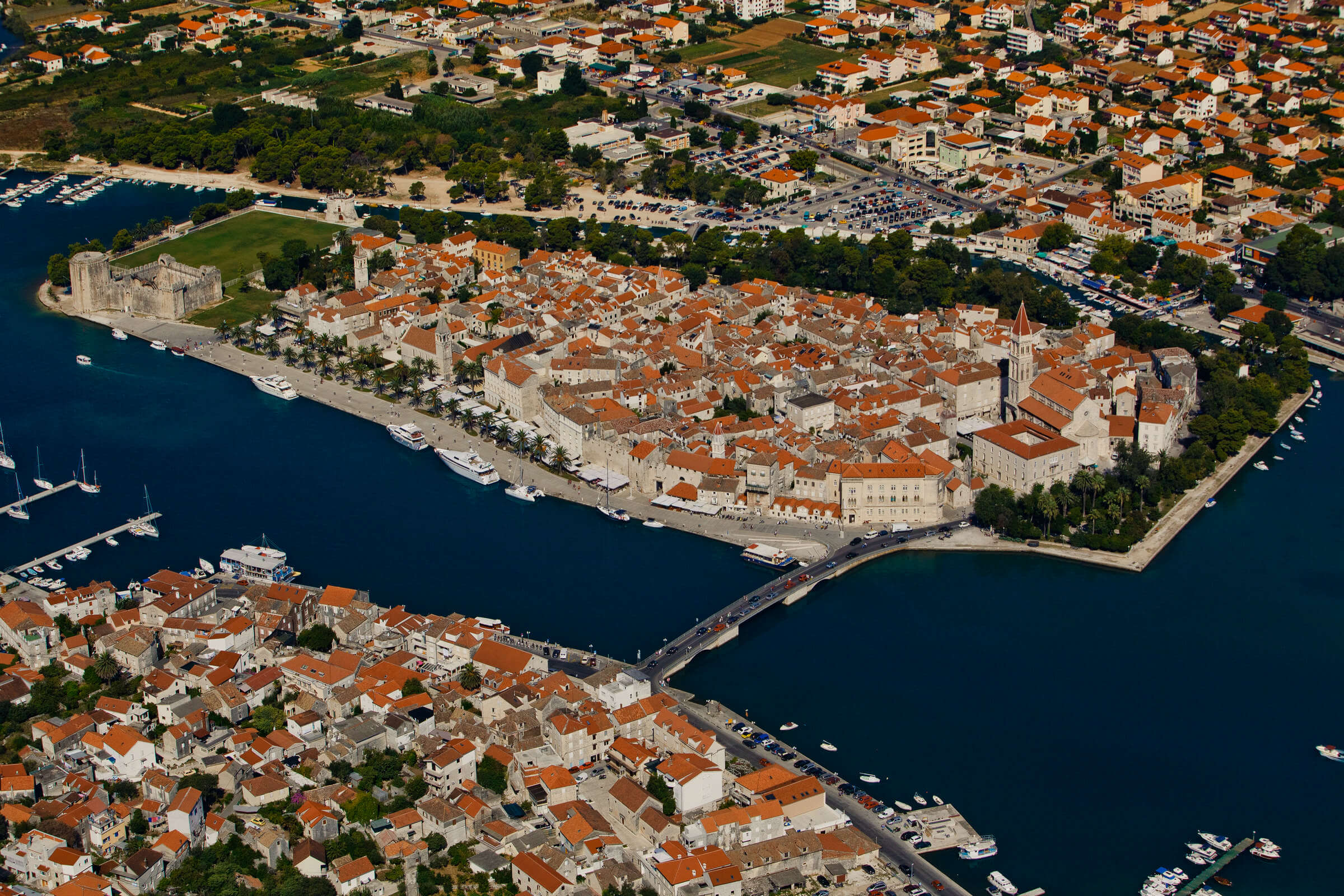
Photo: Mario Romulić
Trogir is a unique example in the history of European architecture and is the city with the largest number of signs or stone markings in Europe. Each brand has its own meaning. Some of them mark the end of construction, some represent the personal signature of the master, and some are engraved votive prayers. The masters also carved games in stone, such as chess, which was used as entertainment during their construction break.
Source: Trogir Tourist Board
Roman Amphitheatre in Solin
At the westernmost point of Solin (Salona) lies the most recognizable building of Roman architecture, the Amphitheatre, in the second half of the second century A.D. The remains of such an imposing Roman amphitheater indicate that gladiator fights were held in the city of Salona just as in other parts of the Roman empire, until the fifth century when they were banned.
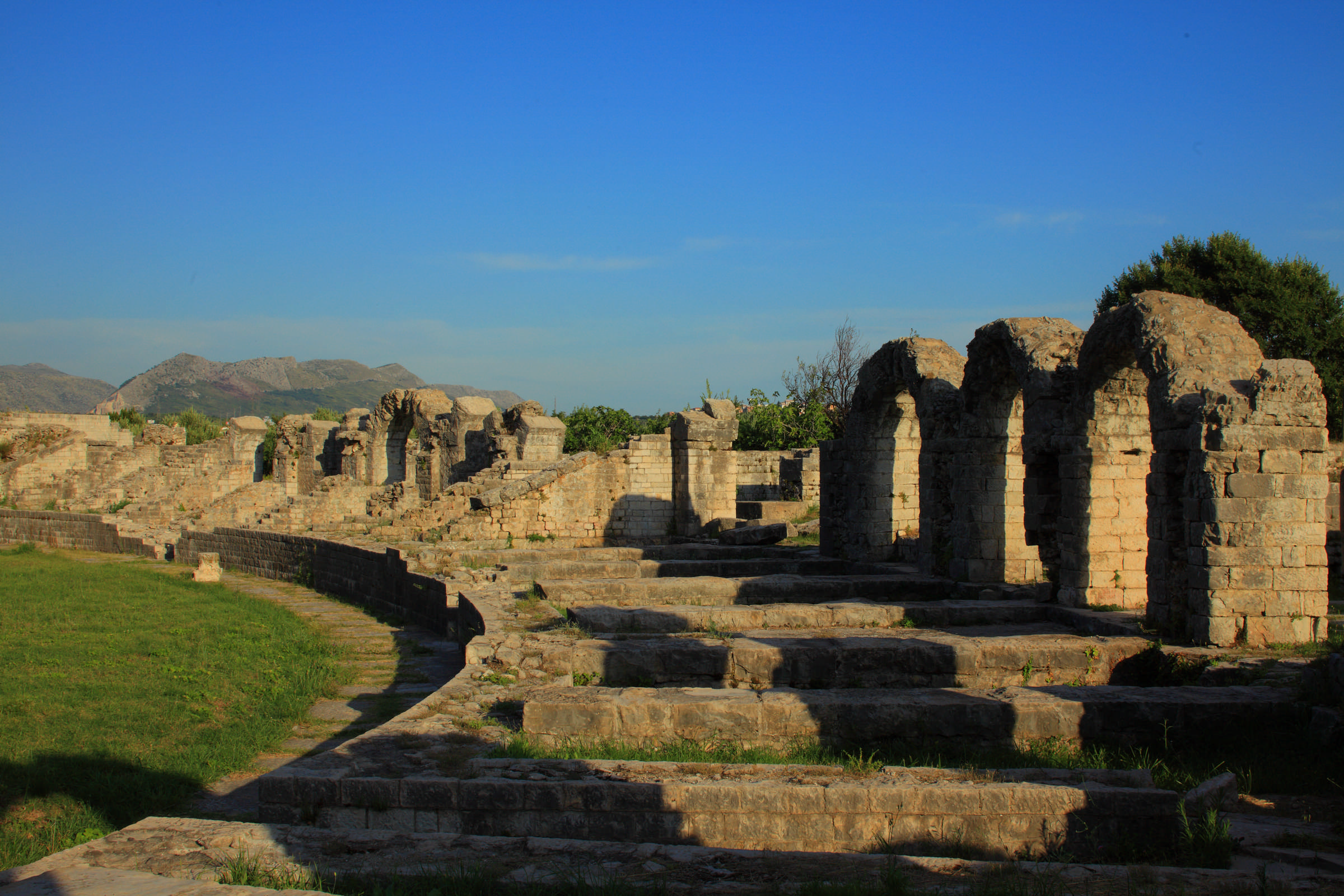
Photo: Mario Romulić
The building was ellipsoidal in shape, with three floors on the south side and one floor on the north side, which was conveniently laid down on a natural hillside. Despite its relatively small size (125 by 100 meters outer shell and 65 by 40 meters the arena), the Salonitan amphitheater could have been occupied by 15,000 up to 18,000 spectators. The auditorium was divided into three tiers, the lower two with seats and the upper one for standing.
Source: Solin Tourist Board
Diocletian's Palace in Split
Diocletian's Palace is one of the best-preserved monuments of Roman architecture in the world. The Emperor's Palace was built as a combination of a luxury villa - a summer house and a Roman military camp (castrum), divided into four parts with two main streets. The southern part of the Palace was intended for the Emperor's apartment and appropriate governmental and religious ceremonies, while the north part was for the Imperial guard - the military, servants, storage, etc.
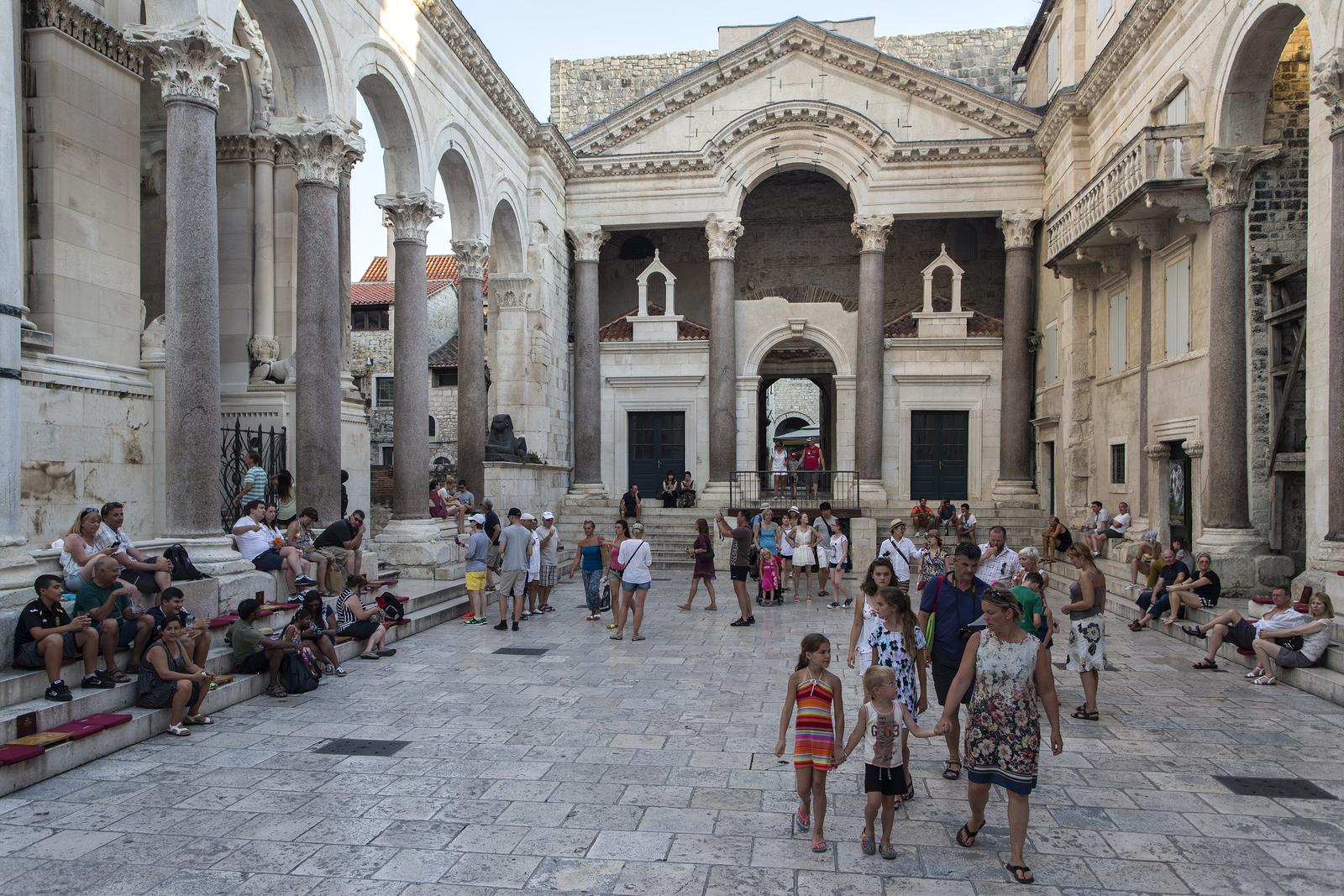
Photo: Davor Puklavec/PIXSELL
The Palace is a rectangular building (approximately 215 x 180 meters) with four large towers at the corners, doors on each of the four sides, and four small towers on the walls. The lower part of the walls has no openings, while the upper floor is open with a monumental porch on the south and halls with grand arch windows on the other three sides. Over the centuries the Palace inhabitants, and later also the citizens of Split adapted parts of the palace for their own requirements, thus the inside buildings, as well as the exterior walls with the towers, significantly changed the original appearance, but the outlines of the Imperial Palace are still very visible.
Source: Split Tourist Board
Walls of Ston
The walls of Ston were built in 1333 when Ston became a part of the Republic of Dubrovnik. Their purpose was to defend the Republic and the peninsula. Dubrovnik government in 1335 and amended in 1370 and is considered one of the best planned and best structured cities in Europe. The walls of Ston were a massive architecture and construction feat. Originally 7000-meters long (22 965 ft.), they consist of several parts; the Ston city walls, the Mali Ston city walls, and the Big wall with its three forts.
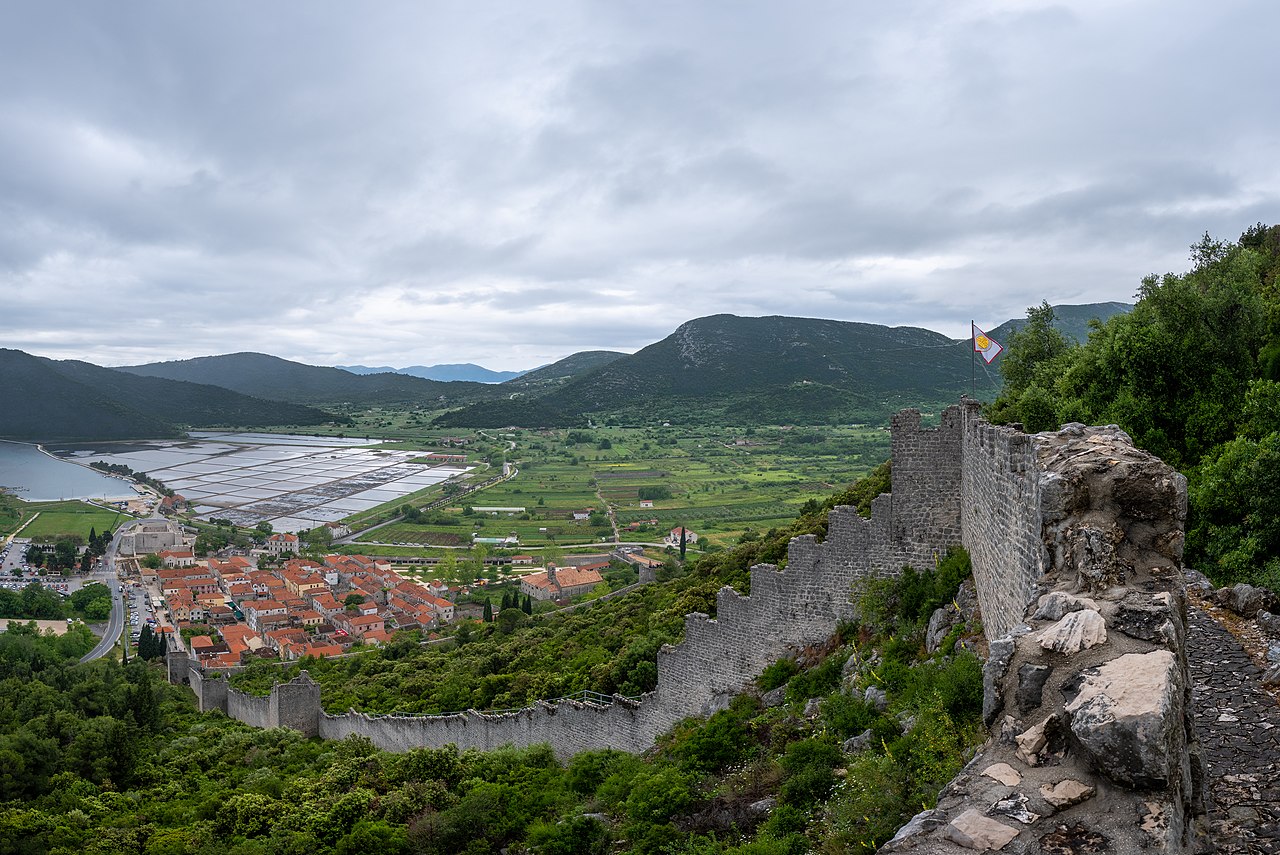
Photo: Jules Verne Times Two/Wikimedia Commons
Its forts and towers are strengthened by 10 round and 31 square flanking towers and 6 semi-circular bastions. The walls were last used in the 19th century for the defense of the city and salt pans, and today they are priceless monuments of immense architectural and cultural value. You can visit the Walls during the whole year. Take a walk around the city of Ston (in roughly 20 minutes) and from Ston to Mali Ston (in roughly 40 minutes).
Source: Ston Tourist Board
Walls of Dubrovnik
The successful development of Dubrovnik in the past was conditioned primarily by its favorable geographical position, and by an economy based on maritime and merchant activities. When entering the Adriatic Sea, Dubrovnik is the first island-protected port on the maritime route going from east to west, with quick access to the hinterland by way of the Neretva Valley. Latest archaeological research has shown that a settlement dating to the 6th century or probably even earlier existed under today's city. It expanded with the arrival of the Croats in the 7th century, following the abandonment of ancient Epidaurus (today's Cavtat).
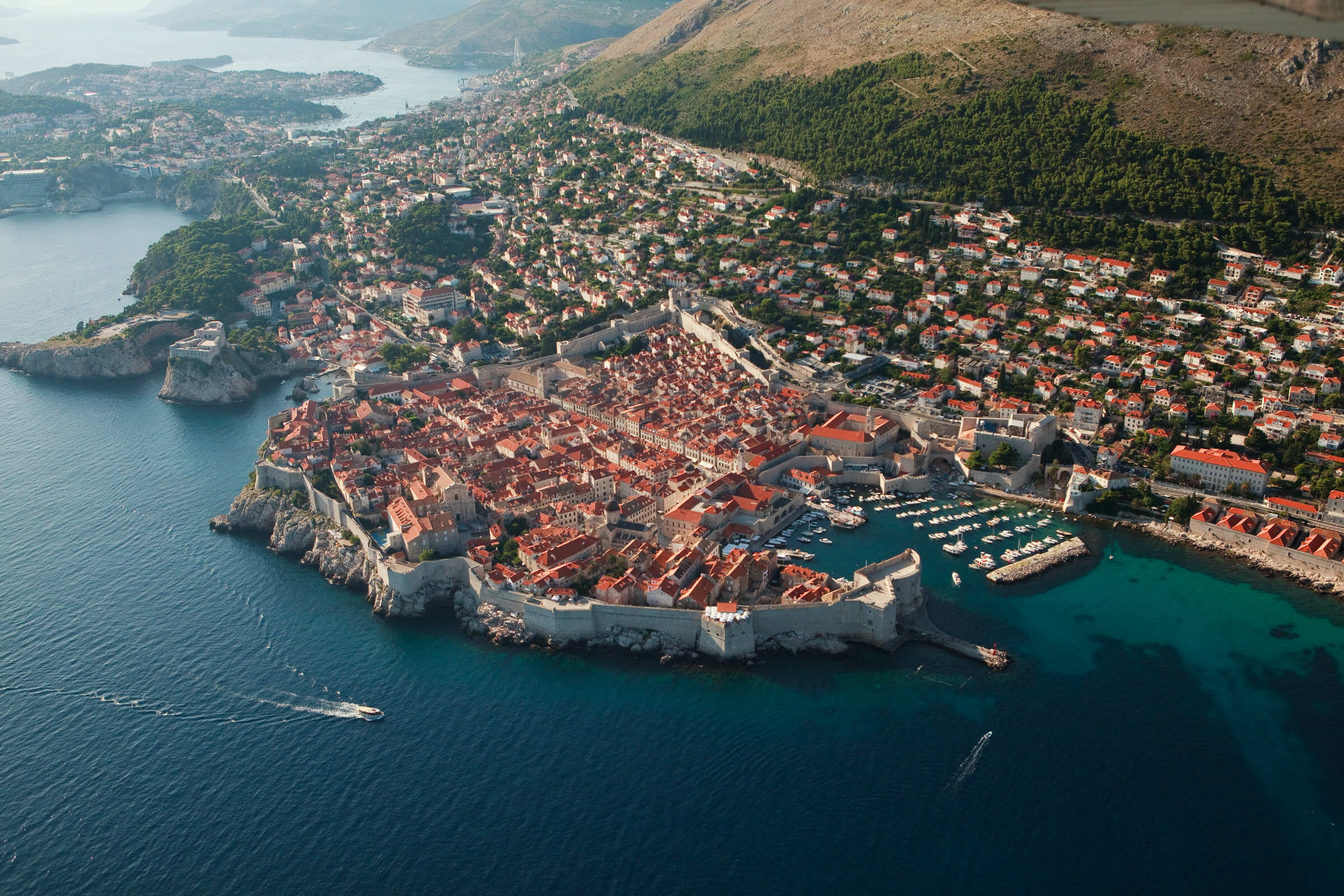
Photo: Mario Romulić
The intensification of traffic between the East and West both during and after the Crusades resulted in the development of maritime and mercantile centers throughout the Mediterranean and the Adriatic Sea in the 12th and 13th centuries. Dubrovnik was one of them. The Zadar Treaty in 1358 liberated Dubrovnik from Venetian rule, and it was crucial to the successful furthering of its development.
For more on travel in Croatia, follow TCN's dedicated page.
The Ultimate Guide For Digital Nomads in Dubrovnik
May 28, 2022 - Dubrovnik's first digital nomad ambassadors are giving back - a few hints and tips for DNs coming to visit the Pearl of the Adriatic.
This guide has been written by Yvette Pelgrom and Mandy Fransz to share their top tips and recommendations after working remotely in Dubrovnik, Croatia as the inaugural Digital Nomad Ambassadors, a pro-bono concept designed and deivered by Saltwater Nomads, in partnership with the Dubrovnik Tourist Board and City of Dubrovnik.
With its Mediterranean vibe, impressive culture and history, beautiful nature, extremely friendly locals, and surrounded by islands with crystal clear water, we truly believe that Dubrovnik is a must-visit city to add to your bucket list!
For the last few weeks, we’ve had the amazing opportunity to experience the digital nomad lifestyle of this magical “Kings Landing” city as a Digital Nomad Ambassador.
In this guide, we happily share our experiences to hopefully provide you with the tips and recommendations needed to create the ultimate digital nomad experience!
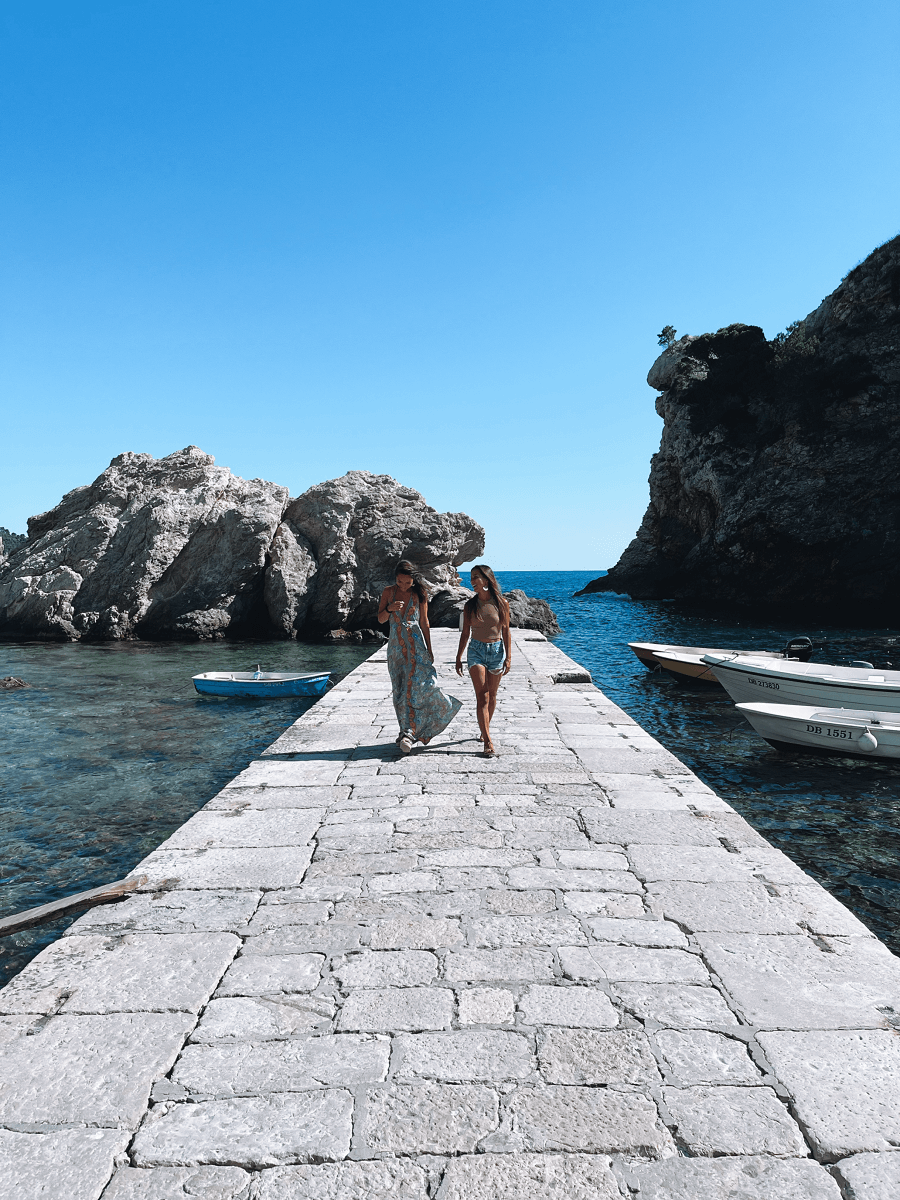
Where to stay:
During our 3-week stay, we’ve stayed at a different apartments each week which gave us the opportunity to explore different areas of Dubrovnik.
One of our favorite areas is Lapad, which is about 10 minutes by taxi (approx. €6- one-way by Uber or Bolt) to the Old Town. We stayed in Dvori Lapad which was only a few minutes walk from Sunset Beach where you can walk alongside the beautiful promenade filled with hotels and restaurants serving delicious fish and seafood.
Another area we enjoyed during our stay was only a 7-minute walk up the hills from Old Town. We stayed at Apartments Lora which offered one of the best views from our big (+ sunny!) terrace right on top of Old Town and the magical Lokrum island. A little side note: you do need to walk a few stairs to get here, but it’s worth the view!
(Apartment Lora)
Where to eat:
Our favorite restaurant is Urban & Veggie, which is conceived as “Dubrovnik's vegecentric sustainability hotspot” offering the best vegan and healthy options in town. Definitely try their Veggie Burger while you’re there!
Another favorite is Nishta, a small place in the middle of Old Town that offers vegan, raw and gluten-free dishes, including a salad bar. Their falafel wrap is delicious! A few other restaurants in Old Town that we really enjoyed are Castro (pizza / pasta), Kamenice (budget-friendly seafood), Kopun (seafood - a bit more fancy / higher prices), and Arsenal (amazing harbour view - a bit more fancy / higher prices).
Finally, we highly recommend walking alongside the promenade in Lapad for delicious fish and seafood restaurants such as Casa (incl. very friendly staff who kindly allowed us to work remotely with an ocean-view while enjoying a seabass for lunch!)
(Casa)
Where to work:
As digital nomads, having a work-friendly home office is essential. Hence, make sure to find accommodation with high-speed Wi-Fi, enough space to work from, and/or ideally, a dedicated desk to comfortably work-from-home.
While Dubrovnik currently doesn’t have many co-working spaces, we truly believe that Lazareti has the potential to become one of the most beautiful co-working spaces worldwide! With an exceptional location only a few minutes wak from Old Town and a picture-perfect view the Adreatic sea, this makes it the perfect place to work and meet like-minded people. During our stay, Yvette Pelgrom (one of the Digital Nomad Ambassadors) hosted a Workshop ‘Life Design for Wellbeing’ which was a great way to bring together digital nomads and expats in Dubrovnik.
(Lazareti co-working space)
Finally, we regularly worked from the previously mentioned Urban & Veggie, which offers a few work-friendly tables with electrical outlets and an outside garden which makes it a perfect spot if you’re looking to switch up work environments.
Things to do:
There is no reason to be bored in Dubrovnik! There are a lot of fun activities including walking the Dubrovnik Walls, going for a Karaka sunset tour, sea kayaking, exploring Kings Landing with a Game of Thrones tour (highly recommend Dubrovnik Tourist Guide!), or enjoying a cocktail during sunset at the Buza Cliff Bar.
Dubrovnik is the perfect place to start your day with a dip in the sea. A few of our favorite beaches include Banje Beach nearby Old Town, Sunset Beach in Lapad, and St Jacobs Beach which is a ~20-minute walk alongside the coast and is located next to the old ruins of Hotel Belvedere, a Game of Thrones venue! You can also take a ~35-minute drive to the secluded Pasjaca Beach, a must-visit according to locals.
If you’re a little more adventurous, you can also hike the Srd hiking trail, which takes you within 45-minutes to the top at the Panorama restaurant with a breathtaking view. Also, we recommend exploring “hidden gems” within walking distance such as the romantic seaview point we discovered in Velika and Mala Petka Forest Park.
Last but not least, for a unique experience we highly recommend Koshara picnic to enjoy an Instagrammable picnic with a view in beautiful locations such as Gradac park (yes, another Game of Thrones venue!).
General tips & recommendations
Want to live in Croatia for a year? Check out the digital nomad visa by DNA Croatia.
Want to meet fellow digital nomads in Dubrovnik? Join the Facebook group here.
We hope this guide will help you to create the ultimate digital nomad experience in Dubrovnik. Do you have any other tips and recommendations? Feel free to leave a comment below!
(Lazareti co-working space, just outside the Old Town)
This guide is written by Yvette Pelgrom and Mandy Fransz to share their top tips and recommendations after working remotely in Dubrovnik, Croatia as the inaugural Digital Nomad Ambassadors, a pro-bono concept designed and deivered by Saltwater Nomads, in partnership with the Dubrovnik Tourist Board and City of Dubrovnik.
For more news and features on digital nomads in Croatia, check out the dedicated TCN section.
Czech Media Warns Tourists Not to Travel Due to Jellyfish in Istria?
May 27, 2022 - Czech media recently warned Czech tourists about jellyfish in Istria, making them think twice before planning a summer holiday on the Croatian peninsula.
The season could not officially start until foreign media had something, well, out of the ordinary to say, which is exactly what happened in the Czech media about tourists going to Istria.
Namely, a Czech magazine recently published false news that the Croatian coast was flooded with jellyfish, which could ultimately jeopardize the tourist season. The Czechs allegedly called on their citizens not to spend their summers in Istria, to which the Istria County Tourist Board quickly responded, Glas Istre writes.
It is true that fishers had problems with jellyfish last winter, but the Czech media misinterpreted the news, said the Istria County Tourist Board. Guests from the Czech Republic and Slovakia also sent inquiries to the Istria County Tourist Board, and one Slovak who planned to go on holiday in early June asked if the story about the jellyfish invasion was true.
The director of the Istria County Tourist Board, Denis Ivošević, says that they sent a statement to the Czech and Slovak media this week "about the real situation in the Adriatic", which is why they asked for the opinion of experts.
Ivošević assumes that someone from the Czech Republic read a story in Croatian media about fishers complaining about jellyfish over winter and transmitted the news with a delay, interpreting it completely wrong. He pointed out that there was no danger for swimmers and that the news about the mass appearance of jellyfish on the Istrian coast was fabricated. Istrian fishers have also confirmed that jellyfish have almost completely disappeared from their waters.
One Czech magazine, on the other hand, writes that the beaches in Piran, Savudrija, Umag, Poreč, Vrsar, and the entire Italian coast of the Friuli Venezia Giulia region are "covered with transparent slimy jelly".
How about that story to kick off the season?
For more, make sure to check out our dedicated lifestyle section.





